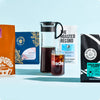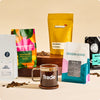Have you ever wished that there was a matchmaking app for you and the coffee you should be drinking? Especially this time of year, the options seem to be limitless: cold brew, flash-chilled, iced latte, iced Americano, any number of iced signature drinks… How’s a body to choose?
Well, we can’t necessarily help you with all of your iced-drink conundrums, but we’d love to guide you through whether it’s cold brew or iced coffee you’re looking for.
What’s the Difference?
Great question, we’re glad you asked.
The primary difference between cold brew and iced coffee is in their very names: “Cold brew” is coffee that is brewed using cold (or room temperature, but not hot) water, which requires a long brewing cycle and usually creates a concentrated beverage. “Iced coffee” you can think of as being hot coffee that is made cold, often by flash-chilling, or brewing it directly onto ice, which is a quicker process.
Due in large part to the difference in their extraction processes (more about this in a moment, though the link above gives a detailed breakdown), cold brew and iced coffee generally have different profiles. Let’s take a closer look at them.
Cold brew Selecting the right coffee beans for cold brew is an important element in achieving the best flavor profile, and smoothness is one of the most noticeable aspects of cold brew's taste. Some describe it as being like the coffee equivalent of chocolate milk. Because hot water is necessary to dissolve some of the more acidic or “bright” compounds from roasted coffee, cold brew tends to have more bass than treble, with chocolate, nuts, caramel, and brown sugar or molasses flavors to the fore. Depending on the dilution level (as cold-brewed coffee typically makes a very highly caffeinated concentrate), it tends to be richer or creamier than most flash-chilled coffee, and is often used as a base for signature or composed drinks.
Iced coffee Brewing hot coffee directly over ice — a process known as flash chilling or Japanese-style brewing — has more of an ability to lock in the delicate flavors that a coffee might have, such as florals, bright and effervescent fruity tones, and lighter sweet notes such as honey or cane sugar. That’s because the compounds that create those flavors require hot water to dissolve them.
More about extraction
As mentioned above, cold-water extraction will take longer than hot-water extraction, which means that when you’re considering your iced options, you’ll want to know how much time you have.
Cold-brewed coffee generally takes between 12 to 24 hours to brew, though all but about five minutes of that is passive time: All you need to do is grind the coffee, put it in a filter, and submerge it in water. The next day, you’ll have read-to-use cold-brew concentrate that will last up to two weeks in the fridge, and can be both diluted to iced-coffee-like strength or used as an ingredient in a coffee cocktail or mocktail.
Iced coffee takes the same amount of time to make as a batch of hot coffee does, typically between three to five minutes. It’s instantly chilled, which means it’s ready to drink immediately after brewing, though it typically is best consumed within the first 48 hours after being made. Since it’s already diluted to a drinkable level during the brewing process, it’s much harder to use iced coffee in any application other than as a beverage served straight-up.
What about caffeine?
The question of which types of coffee have the most caffeine is an interesting one, in part because it’s very difficult to answer in a generalized way. For starters, Arabica coffee has roughly half the caffeine content of Robusta coffee, so knowing the species of coffee present in a bag or a blend is important. (Some Arabica cultivars are hybrids of Arabica and Robusta coffees, which complicates things even further.)
Second, the caffeine by volume, which we can call CBV, is a significant measure, much as alcohol by volume (ABV) is when it comes to beer, wine, and spirits. For example, a shot of espresso will naturally have a higher CBV than brewed coffee because it is a much smaller beverage, diluted considerably less by water.
Cold-brewed coffee is, like espresso, a concentrate: The concentrate itself has a higher CBV, but once diluted it’s relatively comparable to hot or iced coffee. Concentrated cold brew has roughly 60 to 65 milligram of caffeine per ounce, where hot brewed coffee has about 12 to 15 milligram per ounce. However, a cold-brew coffee drink tends to contain about two ounces of concentrate (120 to 130 milligram caffeine) and six to eight ounces of water, where eight ounces of hot-brewed coffee would contain roughly 72 to 120 milligram caffeine. Flash-chilled iced coffee generally contains between 90 to 120 milligram caffeine.
TL;DR: the absolute basics
Need it in a hurry: Iced coffee
Have a little time: Cold brew
Like chocolate, nuts, rich sweet flavors: Cold brew
Fruit and floral, lighter sweet flavors: Iced coffee
Loves creamy texture: Cold brew
Likes a softer mouthfeel: Iced coffee
Wants to prep a lot ahead of time: Cold brew
Doesn’t need it to keep a long time: Iced coffee
Wants to drink it straight up: Iced coffee
Might want to make a cocktail or mocktail: Cold brew
No fancy brewing equipment: Cold brew
Pour over or automatic brewer: Iced coffee









